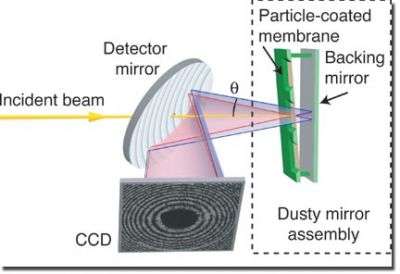Researchers rely on Newton's interference for new experiment

Most people think of Sir Isaac Newton as the father of gravity. But for Lawrence Livermore National Laboratory physicist Henry Chapman and his colleagues, Newton's “dusty mirror” experiment served as a launching pad for them to keenly watch the X-ray induced explosion of microscopic objects.
Using the FLASH soft-X-ray free-electron laser (FEL) in Hamburg, Germany, the team blew up a plastic sphere, but used that same laser pulse to look at the sphere a split second later by placing an X-ray mirror right behind the object. A hologram (three-dimensional image of the object) formed through interference, which was caused when the light scattered through the sphere the first time combined with the light scattered through the sphere the second time (the light bounced back through the object from the mirror).
“We know from previous work we did at FLASH that the object did not explode during the initial 25-femtosecond pulse, and that forms the known reference wave of the hologram,” Chapman said. “The reference wave can be used to determine the unknown object wave, which is actually the same object, but a split second later.”
So where does Newton come in?
Newton created one of the earliest observations of interference in his “dusty mirror” experiment. In a darkened room, he used a prism and a small hole in a screen to form a quasi-monochromatic beam from sunlight, which he shone onto a back-quick silvered mirror. The mirror was angled to return the beam back through the hole and on the screen. Newton observed dark and light rings of light, which he found “strange and surprising.” It was 100 years later when the British scientist Thomas Young determined the rings were caused by interference at the screen between two paths of light scattering from dust particles on the mirror's front surface.
The research appears in the Aug. 9 edition of the journal, Nature.
Chapman designed the experiment after visiting the Chabot Space and Science Center with his wife (Sa_a Bajt, another author on the paper) and daughter. There was an optics exhibit that would let you see interference by looking down a long tube, which had a mirror at the bottom. When you held a small penlight close to the eye, you saw colored curved fringes in the mirror's reflection. The exhibit was described as the dusty mirror experiment. “It suddenly struck me that you could do the same thing with short pulses and X-ray mirrors, and it would be really interesting if the X- ray pulse was shorter than the time it takes for it to travel from the dust particle to the back of the mirror and back,” Chapman said.
And so the experiment was born.
The experiment is part of LLNL's Laboratory Directed Research and Development project: “Biological Imaging with Fourth-generation Light Sources” to develop the technique and determine the feasibility for single-molecule imaging experiments to be carried out at the Linac Coherent Light Source (LCLS) at Stanford when it comes on line.
Unlike the static conditions of Newton's experiment, in the recent experiment the object is ultimately vaporized by the X-ray pulse and the object size changes in the brief interval that the pulse takes to reflect back to the particle. The time it takes the pulse to return is encoded in the fringe pattern of the X-ray hologram, and this can be “read out” from the hologram to an accuracy of about 1 femtosecond. Coupled with the short wavelength of X-rays, the measurements give information simultaneously at the highest spatial resolution and time resolution for general noncrystalline materials.
“This experiment allows us to study the dynamics of material in the extreme conditions of intense FEL pulses, both during the pulse and as it turns into plasma,” Chapman said.
Plasma is considered to be a fourth state of matter, an ionized gas that has distinct properties. Until the recent experiment, there had been no structural methods to follow the early steps in plasma formation. Understanding these initial processes is crucial to future near atomic-resolution imaging experiments at LCLS. The key is to use short pulses to beam the damage and get a high-resolution image of the object before it explodes.
Source: Lawrence Livermore National Laboratory




















